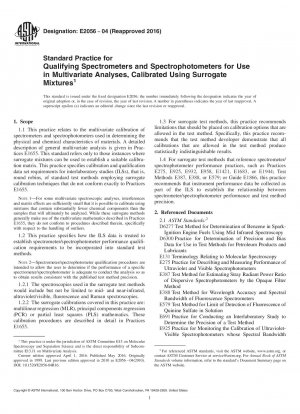ASTM E2056-04(2016)
Standard Practice for Qualifying Spectrometers and Spectrophotometers for Use in Multivariate Analyses, Calibrated Using Surrogate Mixtures
- Standard No.
- ASTM E2056-04(2016)
- Release Date
- 2016
- Published By
- American Society for Testing and Materials (ASTM)
- Latest
- ASTM E2056-04(2016)
- Scope
- 1.1 This practice relates to the multivariate calibration of spectrometers and spectrophotometers used in determining the physical and chemical characteristics of materials. A detailed description of general multivariate analysis is given in Practices E1655. This standard refers only to those instances where surrogate mixtures can be used to establish a suitable calibration matrix. This practice specifies calibration and qualification data set requirements for interlaboratory studies (ILSs), that is, round robins, of standard test methods employing surrogate calibration techniques that do not conform exactly to Practices E1655. NOTE 1—For some multivariate spectroscopic analyses, interferences and matrix effects are sufficiently small that it is possible to calibrate using mixtures that contain substantially fewer chemical components than the samples that will ultimately be analyzed. While these surrogate methods generally make use of the multivariate mathematics described in Practices E1655, they do not conform to procedures described therein, specifically with respect to the handling of outliers. 1.2 This practice specifies how the ILS data is treated to establish spectrometer/spectrophotometer performance qualification requirements to be incorporated into standard test methods. NOTE 2—Spectrometer/spectrophotometer qualification procedures are intended to allow the user to determine if the performance of a specific spectrometer/spectrophotometer is adequate to conduct the analysis so as to obtain results consistent with the published test method precision. 1.2.1 The spectroscopies used in the surrogate test methods would include but not be limited to midand near-infrared, ultraviolet/visible, fluorescence and Raman spectroscopies. 1.2.2 The surrogate calibrations covered in this practice are: multilinear regression (MLR), principal components regression (PCR) or partial least squares (PLS) mathematics. These calibration procedures are described in detail in Practices E1655. 1.3 For surrogate test methods, this practice recommends limitations that should be placed on calibration options that are allowed in the test method. Specifically, this practice recommends that the test method developer demonstrate that all calibrations that are allowed in the test method produce statistically indistinguishable results. 1.4 For surrogate test methods that reference spectrometer/ spectrophotometer performance practices, such as Practices E275, E925, E932, E958, E1421, E1683, or E1944; Test Methods E387, E388, or E579; or Guide E1866, this practice recommends that instrument performance data be collected as part of the ILS to establish the relationship between spectrometer/spectrophotometer performance and test method precision.
ASTM E2056-04(2016) Referenced Document
- ASTM D6277 Standard Test Method for Determination of Benzene in Spark-Ignition Engine Fuels Using Mid Infrared Spectroscopy
- ASTM D6300 Standard Practice for Determination of Precision and Bias Data for Use in Test Methods for Petroleum Products and Lubricants
- ASTM E131 Standard Definitions of Terms and Symbols Relating to Molecular Spectroscopy
- ASTM E1421 Standard Practice for Describing and Measuring Performance of Fourier Transform Mid-Infrared (FT-MIR) Spectrometers: Level Zero and Level One Tests*, 2021-09-01 Update
- ASTM E1655 Standard Practices for Infrared Multivariate Quantitative Analysis*, 2024-04-22 Update
- ASTM E1683 Standard Practice for Testing the Performance of Scanning Raman Spectrometers
- ASTM E1866 Standard Guide for Establishing Spectrophotometer Performance Tests*, 2021-04-01 Update
- ASTM E1944 Standard Practice for Describing and Measuring Performance of Laboratory Fourier Transform Near-Infrared (FT-NIR) Spectrometers: Level Zero and Level One Tests*, 2021-04-01 Update
- ASTM E275 Standard Practice for Describing and Measuring Performance of Ultraviolet, Visible, and Near-Infrared Spectrophotometers
- ASTM E387 Standard Test Method for Estimating Stray Radiant Power Ratio of Spectrophotometers by the Opaque Filter Method
- ASTM E388 Standard Test Method for Spectral Bandwidth and Wavelength Accuracy of Fluorescence Spectrometers
- ASTM E579 Standard Test Method for Limit of Detection of Fluorescence of Quinine Sulfate
- ASTM E691 Standard Practice for Conducting an Interlaboratory Study to Determine the Precision of a Test Method
- ASTM E925 Standard Practice for Monitoring the Calibration of Ultraviolet-Visible Spectrophotometers whose Spectral Slit Width does not Exceed 2 nm
- ASTM E932 Standard Practice for Describing and Measuring Performance of Dispersive Infrared Spectrometers*, 2021-04-01 Update
- ASTM E958 Standard Practice for Measuring Practical Spectral Bandwidth of Ultraviolet-Visible Spectrophotometers
ASTM E2056-04(2016) history
- 2016 ASTM E2056-04(2016) Standard Practice for Qualifying Spectrometers and Spectrophotometers for Use in Multivariate Analyses, Calibrated Using Surrogate Mixtures
- 2010 ASTM E2056-04(2010) Standard Practice for Qualifying Spectrometers and Spectrophotometers for Use in Multivariate Analyses, Calibrated Using Surrogate Mixtures
- 2004 ASTM E2056-04 Standard Practice for Qualifying Spectrometers and Spectrophotometers for Use in Multivariate Analyses, Calibrated Using Surrogate Mixtures
- 2000 ASTM E2056-00 Standard Practice for Qualifying Spectrometers and Spectrophotometers for Use in Multivariate Analyses, Calibrated Using Surrogate Mixtures
